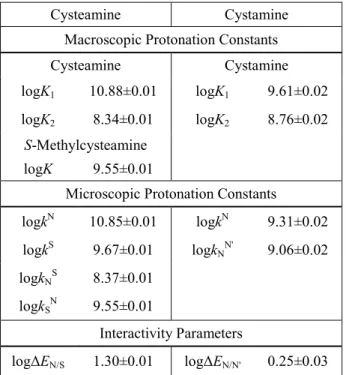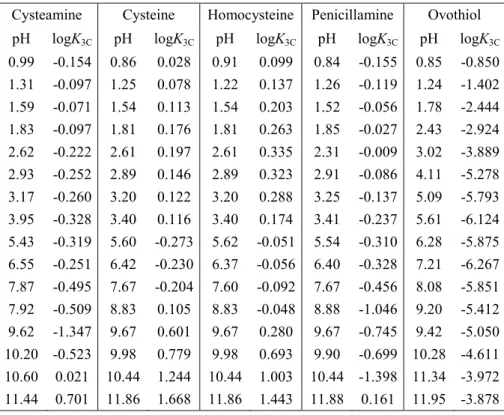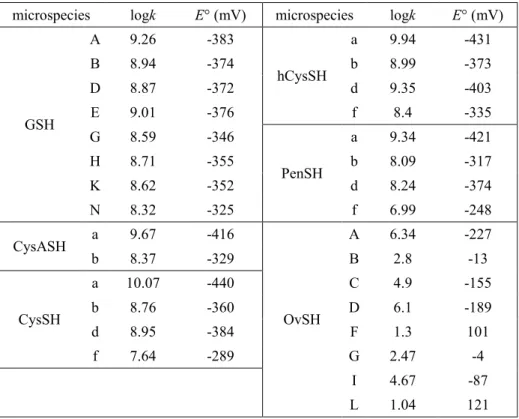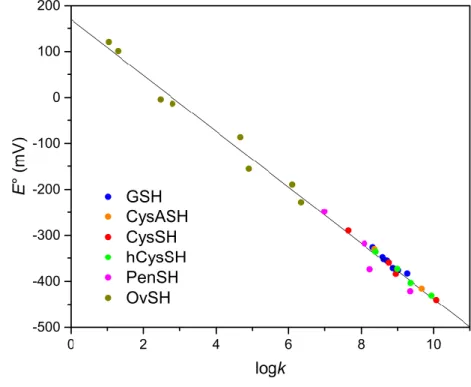CHARACTERIZATION OF THIOL-DISULFIDE ACID-BASE AND REDOX EQUILIBRIA WITH SPECIES-SPECIFIC PARAMETERS
PhD thesis
Arash Mirzahosseini
Doctoral School of Pharmaceutical Sciences Semmelweis University
Supervisor: Béla Noszál, DSc Official reviewers:
Katalin Ősz, PhD Erika Balog, PhD
Head of the Final Examination Committee:
Klára Gyires, DSc
Members of the Final Examination Committee:
György Németh, PhD Lívia Budai, PhD
Budapest, 2017
2
INTRODUCTION
The underlying fundamental reactions of metabolism, redox reactions, form reactive oxygen species (ROS) amid the natural respiration of every organism. The intracellular redox homeostasis is maintained mainly by oxidoreductase enzymes and coenzymes of the antioxidant system. The redox reactions occurring in biochemical processes, while diverse in character, are one- or two-electron transitions primarily taking the form of thiol-disulfide exchange.
Acting as a ubiquitous antioxidant, glutathione (γ-L-glutamyl-L-cysteinylglycine, GSH) protects cell organelles from reactive oxygen species, precluding thus neurodegenerative, cardiovascular and neoplastic pathobiochemical processes. In order to better understand and influence oxidative stress a thorough elucidation of thiol-disulfide equilibria is certainly required.
It is a key feature of any thiol-disulfide redox system, that only the deprotonated thiol species are active in the redox process, i.e. only the anionic thiolate can be oxidized directly. Since the deprotonated fraction of thiols depends on the solution pH, the oxidation-reduction potential of thiol-containing biomolecules is also pH-dependent.
These interwoven acid-base and redox processes are usually further influenced by overlapping protonation processes of multiple basic centers on the molecule in question. Thus, macroscopic physico-chemical parameters cannot quantify the thiolate moiety specifically. A thorough characterization of the thiol-disulfide equilibria can be achieved by means of species-specific, so-called microscopic parameters.
The redox potentials of GSH and other thiols can only be determined indirectly by measurement of equilibrium constants for their reaction with redox systems of known redox potentials. Since redox and acid-base reactions coexist, the observed apparent redox equilibrium constants are pH-dependent. In order to get a clear insight into the
3
redox equilibria, purified from the protonation effects, an improved evaluation method had to be introduced, including a set of species-specific, new type of redox equilibrium constants.
4
OBJECTIVES
The objectives of the doctoral thesis are the following:
- determination of the species-specific protonation constants of the most important biological thiols and their homodisulfides, namely: cysteamine, cysteine, homocysteine, penicillamine, glutathione, ovothiol, dihydrolipoic acid;
- determination of the species-specific redox equilibrium constants of the thiol- disulfude interchange reactions respective to glutathione;
- determination of the species-specific standard redox potential of glutathione using an indirect redox system for comparison, namely: 1- methylnicotinamide;
- determination of the species-specific standard redox potential of the most important biological thiols.
5
METHODS
For the performance of the measurements mostly manufactured reagents were used, however some substances were synthesized according to existing or newly developed protocols. The following methods were used for the measurements:
NMR spectra were recorded on a Varian 600 MHz spectrometer.
pH-potentiometric titrations were performed with a 716 DMS Titrino automatic titrator with a Metrohm 6.0204.100 combined pH glass electrode.
UV spectroscopy measurements were performed on a Jasco V-550 UV/VIS spectrophotometer.
Electrochemical measurements were performed with a Radeklis OP-6123 redox electrode.
TOF MS measurements were used to determine the exact mass of the synthesized and isolated compounds with an Agilent 6230 time-of-flight mass spectrometer equipped with a JetStream electrospray ion source in positive ion mode.
6
RESULTS
The determination of species-specific protonation constants for every compound was performed based on case-tailored deduction methods. The design of the deductive method is epitomized in detail for the simple case of cysteamine. Cysteamine was titrated under near physiological conditions and non-linear regression analysis of the
1H NMR chemical shift-pH profiles afforded the macroscopic protonation constants presented in Table 1. The relationships between the macroscopic and microscopic protonation constants actualized for cysteamine are:
(1)
𝐾1= 𝑘N+ 𝑘S(2)
𝛽2= 𝐾1𝐾2= 𝑘N𝑘NS = 𝑘S𝑘SNSince cysteamine contains amino and thiolate basic moieties, its protonation is characterized by two first-step microscopic protonation constants (kN, kS – when the amino or thiolate protonates while the neighbouring miety is unprotonated) and two second-step microscopic protonation constants (kSN, kNS – when the amino or thiolate protonated while the neighbouring miety is protonated). Thus, besides the macroconstants, the complete microspeciation of cysteamine needs at least one additional datum. This can be obtained via a deductive method, wherein the possible closest model of a minor microspecies is introduced and some appropriate protonation constant(s) of the model compound(s) is/are regarded as constituent protonation constants of the parent molecule. In the case of cysteamine, S-methylcysteamine was
7
used to model the microspecies, in which the thiolate moiety is protonated. Therefore, the macroscopic protonation constant of S-methylcysteamine (Table 1) was equated to kSN of cysteamine. The remaining microscopic protonation constants were calculated using equations (1) and (2), and are presented in Table 1. These data also yielded the interactivity parameter between the amino and thiolate groups:
(3)
log∆𝐸N/S= log𝑘N− log𝑘SN= log𝑘S− log𝑘NSThe interactivity parameter shows to what extent the protonation of site A reduces the basicity of site B, and vice versa. The interactivity parameter is generally considered to be the most invariant quantity in analogous moieties of different compounds and also in various protonation states of the neighboring moiety in the same molecule.
8
Table 1. The macroscopic and microscopic protonation constants (298 K, 0.15 mol/L ionic strength), and interactivity parameters of cysteamine, cystamine and their model compound in log units ±s.d.
Cysteamine Cystamine
Macroscopic Protonation Constants
Cysteamine Cystamine
logK1 10.88±0.01 logK1 9.61±0.02 logK2 8.34±0.01 logK2 8.76±0.02
S-Methylcysteamine
logK 9.55±0.01
Microscopic Protonation Constants
logkN 10.85±0.01 logkN 9.31±0.02 logkS 9.67±0.01 logkNN' 9.06±0.02
logkNS 8.37±0.01
logkSN 9.55±0.01
Interactivity Parameters
logΔEN/S 1.30±0.01 logΔEN/N' 0.25±0.03
Cystamine, being the disulfide of cysteamine, is a symmetric molecule with two basic nitrogens, which can be arbitrarily named N and N’. Due to symmetry, their basicities are identical:
(4)
𝑘N= 𝑘N′(5)
𝑘NN′= 𝑘NN′9
This reduces the multivariable problem to a system with two unknowns only, which can be resolved using relationships derived from equations (1) and (2):
(6)
log𝑘N= log𝐾1− log2
(7)
log𝑘NN′= log𝐾2+ log2Macroscopic protonation constants from 1H NMR-pH titration data and calculated microscopic protonation constants, along with the interactivity parameter between the two amino groups (logΔEN/N’) are presented in Table 1. The above approach was used to determine the macroscopic and microscopic protonation constants of cysteine, homocysteine, penicillamine, glutathione, ovothiol, dihydrolipoic acid, and their respective homodisulfides.
After the determination of the microscopic protonation constants of the other thiol- containing compounds and their respective disulfides the redox potentials were determined by the following approach. For the thiol-disulfide redox equilibria, only the apparent or conditional equilibrium constants (K3C) are directly available, by determining the equilibrium concentrations of RSH, GSSG, RSSR, and GSH in the reaction mixtures. The conditional equilibrium constants were calculated from the concentrations in the equilibrium reaction mixtures. The conditional redox equilibrium constant values are listed in Table 2.
10
Table 2. The conditional redox equilibrium constants of cysteamine-, cysteine-, homocysteine-, penicillamine-, ovothiol-glutathione thiol-disulfide systems. The uncertainties in the pH and logK3C values are 0.01-0.02 and 0.002-0.004, respectively.
Cysteamine Cysteine Homocysteine Penicillamine Ovothiol pH logK3C pH logK3C pH logK3C pH logK3C pH logK3C
0.99 -0.154 0.86 0.028 0.91 0.099 0.84 -0.155 0.85 -0.850 1.31 -0.097 1.25 0.078 1.22 0.137 1.26 -0.119 1.24 -1.402 1.59 -0.071 1.54 0.113 1.54 0.203 1.52 -0.056 1.78 -2.444 1.83 -0.097 1.81 0.176 1.81 0.263 1.85 -0.027 2.43 -2.924 2.62 -0.222 2.61 0.197 2.61 0.335 2.31 -0.009 3.02 -3.889 2.93 -0.252 2.89 0.146 2.89 0.323 2.91 -0.086 4.11 -5.278 3.17 -0.260 3.20 0.122 3.20 0.288 3.25 -0.137 5.09 -5.793 3.95 -0.328 3.40 0.116 3.40 0.174 3.41 -0.237 5.61 -6.124 5.43 -0.319 5.60 -0.273 5.62 -0.051 5.54 -0.310 6.28 -5.875 6.55 -0.251 6.42 -0.230 6.37 -0.056 6.40 -0.328 7.21 -6.267 7.87 -0.495 7.67 -0.204 7.60 -0.092 7.67 -0.456 8.08 -5.851 7.92 -0.509 8.83 0.105 8.83 -0.048 8.88 -1.046 9.20 -5.412 9.62 -1.347 9.67 0.601 9.67 0.280 9.67 -0.745 9.42 -5.050 10.20 -0.523 9.98 0.779 9.98 0.693 9.90 -0.699 10.28 -4.611 10.60 0.021 10.44 1.244 10.44 1.003 10.44 -1.398 11.34 -3.972 11.44 0.701 11.86 1.668 11.86 1.443 11.88 0.161 11.95 -3.878
The microscopic redox equilibrium constants were calculated from the conditional equilibrium constants using the protonation fractions. Determination of the redox potential of the GSSG/GSH system was achieved indirectly, applying a redox couple with a known standard redox potential. For this purpose the simplest nicotinamide nucleotide analogue system, 1-methylnicotinamide (MNA+, the oxidized form), and 1- methyldihydronicotinamide (MNAH, the reduced form) was used as comparison redox couple. The microscopic or standard redox potential of the GSSG/GSH couple was determined by measuring the redox equilibrium constant between MNAH and
11
GSSG and using the Nernst equation. The standard redox potential of every other thiolate (Table 3) was derived from the microscopic redox equilibrium constants of the thiol-disulfide transitions.
Table 3. Species-specific thiolate protonation constants and standard redox potentials of the corresponding thiol-disulfide systems. The uncertainties in the E° values are 5- 10 mV.
microspecies logk E° (mV) microspecies logk E° (mV)
GSH
A 9.26 -383
hCysSH
a 9.94 -431
B 8.94 -374 b 8.99 -373
D 8.87 -372 d 9.35 -403
E 9.01 -376 f 8.4 -335
G 8.59 -346
PenSH
a 9.34 -421
H 8.71 -355 b 8.09 -317
K 8.62 -352 d 8.24 -374
N 8.32 -325 f 6.99 -248
CysASH a 9.67 -416
OvSH
A 6.34 -227
b 8.37 -329 B 2.8 -13
CysSH
a 10.07 -440 C 4.9 -155
b 8.76 -360 D 6.1 -189
d 8.95 -384 F 1.3 101
f 7.64 -289 G 2.47 -4
I 4.67 -87
L 1.04 121
12
Figure 1. The correlation between species-specific standard redox potentials and the species-specific thiolate protonation constants for the various thiols.
13
CONCLUSIONS
The pH-dependent and species-specific equilibrium constants of the thiol-disulfide redox reactions between glutathione and important biogenic thiols were determined.
The pH-independent species-specific redox equilibrium constant was implemented for the first time for thiol-disulfide systems; these values characterize the redox processes at the microspecies level. The different species-specific equilibrium constant values provide sound means to predict thiolate oxidizabilities, a key parameter to understand and influence oxidative stress. The standard redox potential values determined show close correlation with the respective thiolate basicities. The delicate task of medicinal antioxidants lies in their confinement: ROS (reactive oxygen species) surplus has to be eliminated, while physiological disulfides in proteins and peptides have to be kept intact. The major difficulty in designing effective antioxidants without decomposing the physiological disulfides in biomolecules is that the redox potential of the latter could not so far be determined. The correlation between the redox and acid-base properties (Figure 1) serves now as a sound basis to quantify reducibility of disulfide moieties in physiological proteins and peptides, allowing thus the development of potent, selective antioxidant compounds.
14
PUBLICATIONS
Publications pertaining to the doctoral thesis
1. Mirzahosseini A, Orgován G, Hosztafi S, Noszál B. (2014) The complete microspeciation of ovothiol A, the smallest octafarious antioxidant biomolecule. Anal Bioanal Chem, 406: 2377-2387.
2. Mirzahosseini A, Noszál B. (2014) The species- and species-specific acid- base properties of biological thiols and their homodisulfides. J Pharm Biomed Anal, 95: 184-192.
3. Mirzahosseini A, Szilvay A, Noszál B. (2014) The species- and species- specific acid-base properties of penicillamine and its homodisulfide. Chem Phys Lett, 610-611: 62-69.
4. Mirzahosseini A, Hosztafi S, Tóth G, Noszál B. (2014) A cost-effective synthesis of enantiopure ovothiol A from L-histidine, its natural precursor.
Arkivoc, 6: 1-9.
5. Mirzahosseini A, Orgován G, Tóth G, Hosztafi S, Noszál B. (2015) The complete microspeciation of ovothiol A disulfide: a hexabasic symmetric biomolecule. J Pharm Biomed Anal, 107C: 209-216.
6. Mirzahosseini A, Somlyay M, Noszál B. (2015) The comprehensive acid- base characterization of glutathione. Chem Phys Lett, 622: 50-56.
7. Mirzahosseini A, Somlyay M, Noszál B. (2015) Species-specific thiol- disulfide equilibrium constants: a tool to characterize redox transitions of biological importance. J Phys Chem B, 119: 10191-10197.
15
8. Mirzahosseini A, Noszál B. (2016) Species-specific thiol-disulfide equilibrium constants of ovothiol A and penicillamine with glutathione. RSC Advances, 6: 26757-26764.
9. Mirzahosseini A, Szilvay A, Noszál B. (2016) Physico-chemical profiling of α-lipoic acid and related compounds. Chem Biodivers, 13: 861-869.
10. Mirzahosseini A, Noszál B. (2016) Species-specific standard redox pontential of thiol-disulfide systems: a key parameter to develop agents against oxidative stress. Scientific Reports, 6: 37596.
Publications pertaining to different subjects
1. Mirzahosseini A, Dalmadi B, Csutora P. (2013) Histamine receptor H4 regulates mast cell degranulation and IgE induced FcεRI upregulation in murine bone marrow-derived mast cells. Cell Immunol, 283: 38-44.
2. Mirzahosseini A, Kovács M, Kánai K, Csutora P, Dalmadi B. (2014) BODIPY® FL histamine as a new modality for quantitative detection of histamine receptor upregulation upon IgE sensitization in murine bone marrow-derived mast cells. Cytometry Part A, 87: 23-31.
3. Fiedler GB, Meyerspeer M, Schmid AI, Goluch S, Schewzow K, Laister E, Mirzahosseini A, Niess F, Unger E, Woltz M, Moser E. (2015) Localized semi-LASER dynamic 31P magnetic resonance spectroscopy of the soleus during and following exercise at 7 T. Magn Reson Mater Phy, 28: 493-501.
4. Budai KA, Mirzahosseini A, Noszál B, Tóth G. (2015) Az elhízás gyógyszeres kezelése – The pharmacotherapy of obesity [in Hungarian]. Acta Pharm Hung, 85: 3-17.
5. Fiedler GB, Schmid AI, Goluch S, Schewzow K, Laister E, Niess F, Unger E, Woltz M, Mirzahosseini A, Kemp GJ, Moser E, Meyerspeer M. (2016)
16
Skeletal muscle ATP synthesis and cellular H+ handling measured by localized 31P-MRS during exercise and recovery. Scientific Reports, 6:32037.



